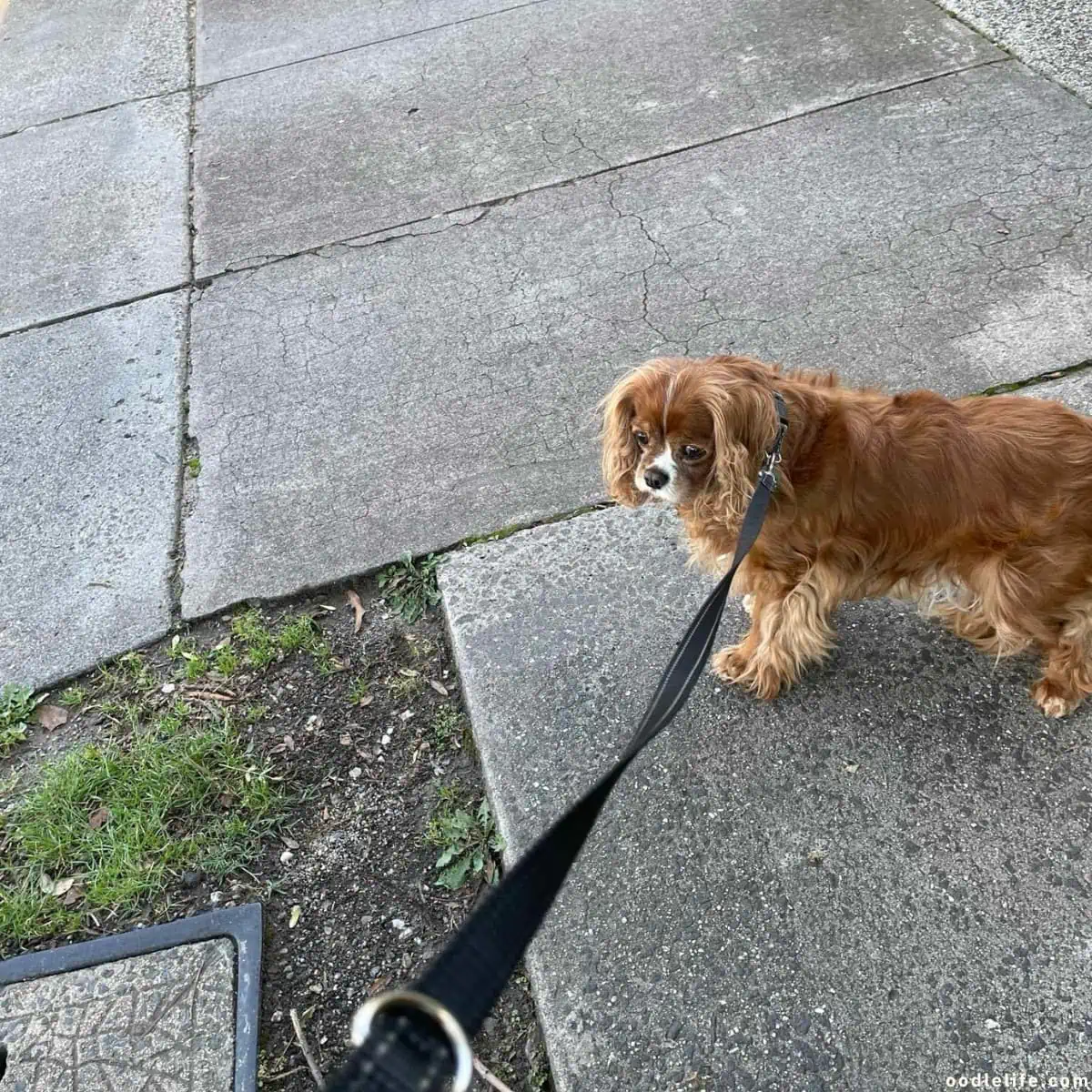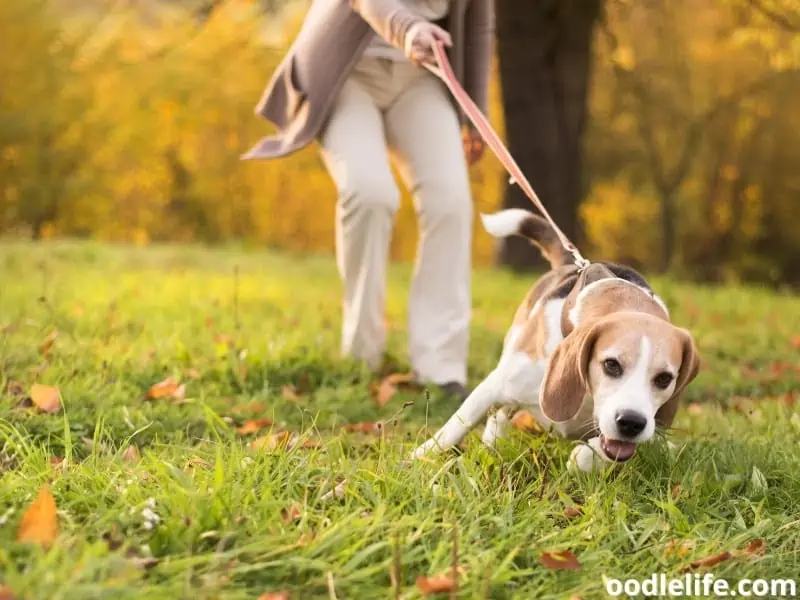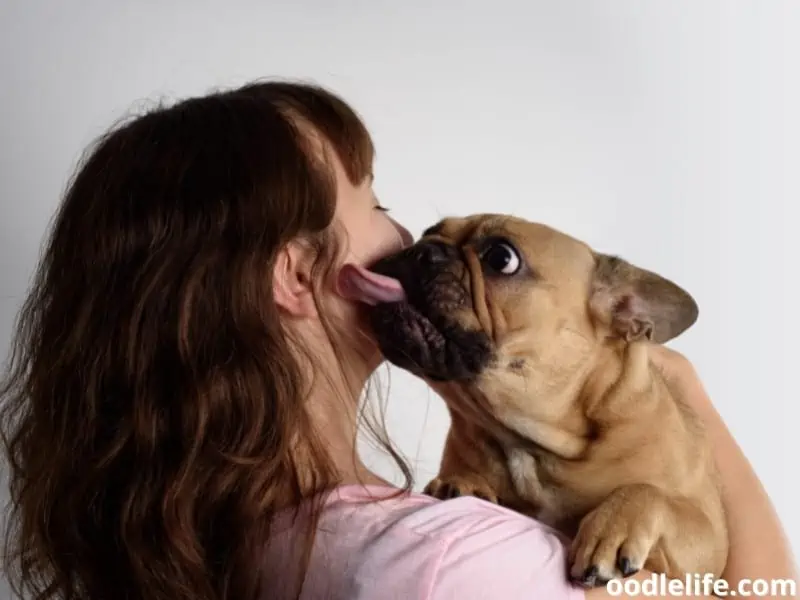Why Does My Dog Freeze on Walks? [Explained]
One of the most frustrating experiences a dog owner can have is when a dog refuses to move when on a walk. Whether you’re just a few feet from home or in the middle of the forest, dogs can be stubborn when they want to get their way!
But why does my dog freeze on walks? Walks are one of my dog’s favorite activities, so it seems odd that they would freeze on walks. But dogs don’t just freeze because they’re lazy or stubborn.

Let’s find out why dogs may freeze when on a walk.
Why Do Dogs Freeze on Walks?
Dogs freeze on walks for a handful of reasons, including fear, physical weakness, bad behavior, and perhaps the most frustrating—they don’t want to go home. Let’s go through these reasons why dogs freeze on walks and explain the cause of each.
Physical Weakness
If you just got a puppy or have an old dog, physical weakness may be the reason why your dog freezes on walks. Just like people, dogs don’t have unlimited stores of energy. They need to stop and take a break sometimes.
And that goes double for young or old dogs.
Although puppies may seem like a bundle of energy, they have their limits. Often, when owners take their puppies for a walk, they’ll get tired and lay on the ground, refusing to move. With such little legs, it’s no wonder they get tired quicker.

Older dogs have similar issues. When a dog is nearing the end of its life, it can be tiring or painful to go on long walks. They may freeze, lay on the ground, or refuse to move forward.
These are all signs your older dog is tired and would rather go home.
Sometimes it’s not simply the fact they’re old. In some cases, chronic conditions like arthritis which is more prevalent in older dogs, make it painful to walk. In these cases, your dog is in pain, and you should reduce their physical exertion.

Physical weakness is one of the most common reasons your dog freezes on walks. When your dog is a puppy, a good way to change its behavior is through training. For an older dog, try to go for walks that fit their fitness level. That way, you won’t have to deal with a frozen dog!
Fear
Dogs are naturally in tune with their senses, even more than people. If you’ve ever wondered why your dog stopped suddenly in the woods, it’s likely because they sensed something you can’t.
When dogs sense things, they often freeze in place so they can get a better read of their surroundings. You’ll notice this quickly because their ears often perk up and their eyes stare off at a random distance.
Unless you live in an area with high numbers of wild animals, your dog’s sensing something that won’t cause you harm. But it’s still best to help them through their fear instead of rushing them along.
To do this, allow the dog time to monitor its surroundings. A dog that understands its surroundings is much less likely to be afraid. Watch their body language. If they relax, gently coax them along your walk.
If this is a common problem for your dog, bringing treats or a toy may help them move along.

Bad Behavior
Dogs are willful animals. If you don’t properly train them, they’ll do whatever they want. That’s why you must train your dog to follow your commands when out in public.
If you don’t you’ll have bigger problems than freezing on walks.
Most bad dog behavior presents as hyperactive behavior, such as pulling on the leash, rushing to strangers, or jumping on people. But one sort of bad behavior people don’t talk about much is when they freeze on walks.
Dogs freeze on walks for multiple reasons, some of which are due to their environment. If your dog freezes after passing something smelly and refuses to move, it may want to eat or smell it.
In other cases, dogs freeze because they know what’s coming. If you drive to the veterinarian, your dog may recognize the parking lot and connect it to bad memories. That’s why it’s common for a dog to refuse to get out of your car when going to some places.
The key to preventing such behavior is active training. Most people stop training their dogs when they grow up from the puppy stage. By training your dog into adulthood, you can ensure they have good behaviors when out in public.

Not Wanting to Go Home
Although this is just one example of bad behavior in dogs, it’s the most common and it causes owners the most grief. If you’ve spent any time around dogs, you’ve seen one that absolutely refuses to go home.
People often experience this when going on a walk or to a place their dog enjoys, like the park or beach. You and your dog will have a great time until you have to leave. Then, the dog will either lay down or refuse to move.
A similar problem occurs when you take your dog for a walk. Once you get near your home, you may notice your dog freezes or lays down. In some cases, they lay on their back, making it even harder to move.
Not wanting to go home is a specific type of bad behavior that causes your dog to freeze. Solving this problem is similar to any other bad behavior, and that means consistent training throughout their lives.
If you allow your dog to dictate where and when they go somewhere, they will continue using those tactics to get what they want. By training the dog throughout their life, you can limit these outbursts of bad behavior.
You need to reinforce the training when your dog reaches adulthood. Sometimes this can be as easy as bringing treats along with you to entice your dog to come home. In other cases, you may need to do extensive training before bringing your dog back to such places.

What to Do When Your Dog Freezes?
Every situation is different, so there’s no one size fits all response when your dog freezes in public. If you have a small dog, you can easily get them moving by picking them up. But for larger dogs, the issue is a bit more complicated.
Large dogs aren’t only too heavy to pick up, but they’re also strong. It’s almost impossible to get a Saint Bernard moving if they don’t want to go! When a large dog doesn’t want to move, you have to rely on training and treats to get them on their way.
Motivating your dog can be a problem, so you must find something your dog loves to coax them. You can use treats, a favorite toy, or anything else your dog loves. Use it as a means to make your dog start moving.
When you use treats or a toy to move your dog, you must reward them when they listen to your commands. Once they listen, you can reward them with their toy or treat. It will make them more likely to listen to you in the future.

Wrapping Up
If you’ve ever wondered why does my dog freeze on walks, it’s most likely due to either fear, weakness, or bad behavior, including not wanting to go home. Experiencing this can be frustrating, especially when you’re out in public.
The only way to fix these behavioral issues is with consistent training. With consistent training, these problems should begin to happen less often. That way, you can enjoy the walks just as much as your pup!